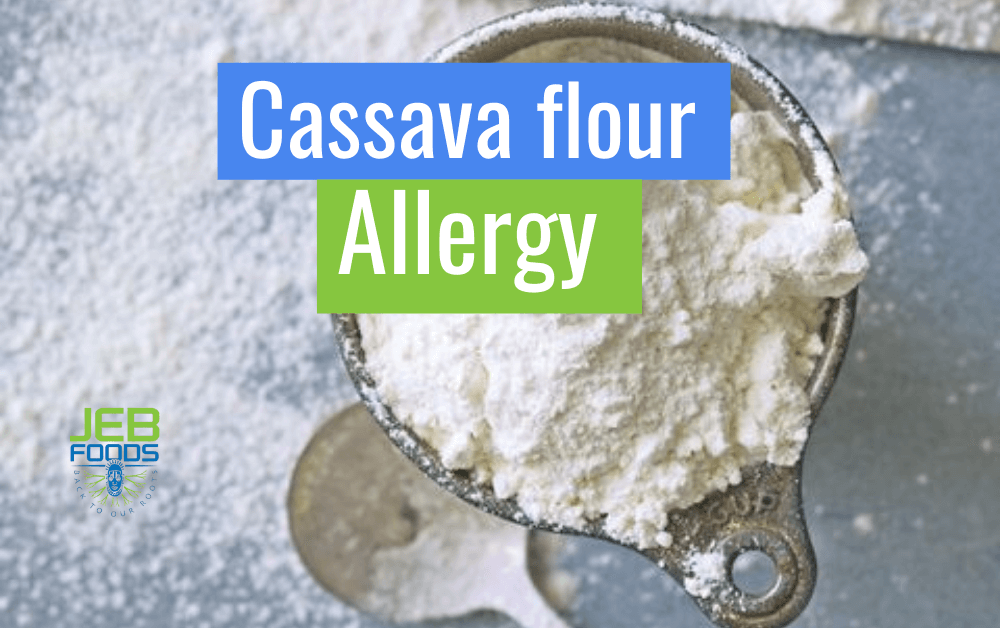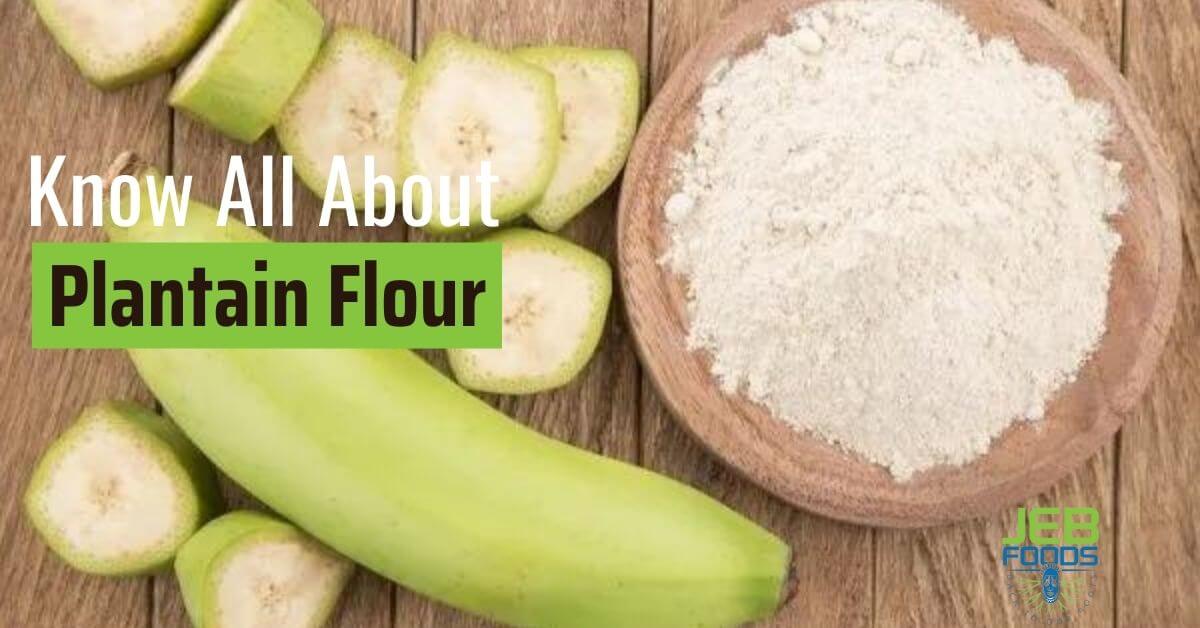Cassava flour allergy and solutions are a major discussion in the baking world among those that fancy cassava flour.
It is a staple meal in tropical nations. Its delectable root has gained popularity among gourmets and home chefs alike.
Despite all the amazing attributes of cassava and the flours processed from it, there are still evident facts that cassava can be very harmful if not processed properly.
Well-processed cassava or cassava flour does not possess any harmful components, and you can see all about this here.
But there have been recorded cases of individuals generally developing allergic reactions to the staple food, which is true about some of the by-products of cassava, such as cassava flour?
Below, we will be showing you all about cassava flour allergy, its symptoms and the possible solutions to them.
Get well-processed cassava flour from Jeb foods
What are the Allergy Symptoms of Cassava Flour
Table of Contents
ToggleThere is very little record of anyone reacting to the consumption of cassava flour. However, if made from poorly processed cassava, individuals may likely see symptoms of cyanide poisoning.
The cause of the poisoning is the hydrocyanic acid – better known as hydrogen cyanide – contained in the tuber and which inhibits many-body systems, attacks nerve cells and affects the functions of the lungs and kidneys
The first symptoms (abdominal pain, nausea) usually appear about three hours after consumption. Vomiting should not be triggered in this situation due to the risk of further digestive system injury.
Bitter cassava is used to make cassava, but in this preparation, it goes through a process that lasts almost 24 hours, which includes drying in the sun, through which the poison is evaporated.
Some basic differences differentiate between bitter cassava and sweet cassava. Although both are externally similar, the bark of the bitter is thicker than the sweet.
The latter also softens faster when cooked, and after boiling, it remains white, while the bitter goes from pink to yellowish.
Experts recommend buying sweet cassava, especially from reputable sources like markets and supermarkets; in this way, you can avoid confusing it in other street stalls.
Cassava flour also causes allergy reactions for those who are allergic to latex. More on this later in this post.
Can Cassava Flour Make You Sick
It is true that cassava, often made into flour, contains the rather dangerous hydrogen cyanide. But this can easily be removed during the preparation.
Cassava, when properly prepared, is generally safe for consumption and seldom causes allergic reactions. The plant only induces allergy reactions to a very small number of people.
However, cross-allergies can occur, which can cause allergic reactions in those sensitive to latex or other rubber-based materials.
On the other hand, the tropical food plant tends to be more helpful for allergies. The unique and nutritious nature of cassava flour makes it a popular choice for gluten-intolerant or grain-allergic persons.
Cassava lovers looking for fresh cassava tubers are most likely to find what they are looking for in Asian or African supermarkets.
See the solution to common illnesses from cassava flour
How to Prevent Cassava from Becoming Harmful
Because of the limited time it has to be consumed after harvest, cassava, particularly in European latitudes, is rarely accessible uncooked as whole food. Cassava can only be stored for three to four days without proper storage.
If you can get your hands on some fresh cassava roots, you should store them in the following way after obtaining them:
Place the roots in a heap or a narrow box, coating them with moist sand or moist sawdust. Cassava may be safely kept in this manner for up to eight weeks before it starts to spoil.
Cassava can only be stored for about 3 weeks if purchased shrink-wrapped in sealed plastic bags. When frozen or waxed, cassava roots can be stored for a long time.
The amount of these chemicals present in cassava varies depending on the variety.
Sweet cassava contains only a small amount of them, less than 50 milligrams per kilogram; however, bitter cassava contains much more than 400 milligrams for every kilogram than sweet cassava.
Bitter cassava must not be consumed raw, but it is fit for cooking. So, the safest way to prevent cassava from becoming a danger to you is to either store it properly or cook it properly.
Here is how to process cassava flour at home
Should Cassava Flour be Consumed At All
Should cassava flour be consumed at all, given cassava’s reputation for being hazardous to the health, especially when it isn’t properly cooked? I mean, shouldn’t we be concerned about the slight risk it poses?
There is no need to be disturbed; however, why? Well, this is because the vast majority of commercial cassava flour has already been thoroughly treated to remove the toxic glycosides. There is no risk of cassava poisoning as a result.
This entails immersing its roots in water for many days, then drying them out in the sun or roasting them, according to information from the Centers for Disease Control and Prevention (CDC).
Following that, the roots are ground into flour once the outer coating has been removed. If any of these procedures are not followed through completely, the levels of cyanogenic chemicals will stay high.
Cassava is generally safe when properly prepared and eaten occasionally in moderate amounts.
It should never be consumed raw since it is very hard since it contains substances called cyanogenic glycosides, which, when decomposed, give rise to toxic compounds.
Checklist for Cassava Flour Processing
Before cassava is processed into cassava flour, there are a few things you can do to make it safe to eat;
- Peel it: The husk of the cassava root contains most of the cyanide-producing compounds.
- Soak it: By soaking cassava in water for 48 to 60 hours before cooking and eating, it can reduce its harmful chemicals.
- Cook it: Raw cassava contains hazardous compounds. Therefore it must be properly cooked, either by boiling, roasting, or baking.
- Pair it with protein: Cassava is great with protein since protein aids in the body’s elimination of harmful cyanide.
- Maintain a balanced diet: You can prevent the adverse effects of cassava by including a variety of foods in your diet and not depending on it as your only source of nutrition.
It is important to note that products made from the cassava root, such as cassava flour and tapioca, contain no cyanide-inducing compound and are safe for human consumption.
There have been isolated occurrences of cyanide poisoning caused by incorrectly processed cassava flour, despite being extremely unusual.
Before their products reach the consumer, manufacturers can conduct safety tests to guarantee that they are safe. When selecting a product, ensure that this type of testing has been carried out on it.
Here is the Health and Nutritional benefits of cassava flour
Cassava Flour Allergy Induced by Latex
Latex allergy is usually very rare. Natural rubber is a product that is extracted from the rubber tree.
However, some people are allergic to latex, and it can prove to be very harmful to your body. Cassava flour can trigger latex allergy. Latex is also found in many consumer products like condoms, handbags, balloons, athletic shoes, tires, rubber toys, baby bottles, nipples and pacifiers. In addition, allergies caused by jewelry are also common.
Symptoms Of Latex Allergy
The symptoms of latex allergy include;
- Itching
- rashes
- chest tightness
- runny nose
- Difficulty Breathing (Tips to Manage Asthma)
- Anaphylaxis, i.e., a severe allergic reaction that causes difficulty breathing or a drop in blood pressure levels
How To Treat Latex Allergy
If conditioned with latex allergy, you should see a doctor as soon as possible.
An allergy blood test usually diagnoses it. To prevent latex allergy, one should avoid direct contact with rubber products and consume trigger foods like cassava and cassava flour.
To prevent the signs of skin allergy, one has to avoid exposure as much as possible. Contacting an allergist as soon as possible is the best course of action for treating an allergic response.
Symptoms of Cassava Flour Allergy Induced by Cyanide Poisoning
Cyanide is a powerful poison that can accumulate in the body, leading to mild symptoms when acute poisoning, such as dizziness, headache, and sleep disorders, or more serious symptoms when poisoning is severe.
In this more severe case, the symptoms range from tingling and numbness of the limbs, muscle weakness, body thinning and vision problems.
Another problem faced by populations that base their diet on this food is endemic goiter since cassava contains thiocyanate. This compound can affect the proper functioning of the thyroid gland.
The sweet variety only needs to be cooked to eliminate toxic components.
However, the bitter cassava will need some prior processing and subsequent cooking, which will reduce the hydrocyanic acid content until it is edible.
For example, in America, cassava flour is mixed with water, forming a thick dough stretched into a thin layer and left that way for about five hours.
At that time, the hydrocyanic acid, a gas, escapes from the dough, leaving the subsequent edible flour.
In Africa, however, they use another system consisting of peeling the root and leaving it in water for three days to ferment. This process also reduces the antinutrient content.
There are many causes of cyanide poisoning, and they all have similar symptoms, which include;
- overall weakness
- Getting nausea
- confusion
- Headache
- shortness of breath
- seizure
- fainting
- cardiac arrest
Individuals may fall victim to cyanide poisoning in two different ways. Symptoms of acute cyanide poisoning can be severe and life-threatening. Exposure to tiny quantities of cyanide over time can result in chronic cyanide poisoning.
Acute Cyanide Poisoning
This type of cyanide poisoning is quite rare, and most victims fall to it unintentionally. When this occurs, the symptoms are sudden and severe. You can experience:
- shortness of breath
- seizure
- fainting
- cardiac arrest
If suffering from severe cyanide poisoning, seek medical attention immediately. This is a life-threatening situation.
Chronic cyanide poisoning
This type of cyanide poisoning usually occurs by ingesting hydrogen cyanide gas over a long period. Symptoms are often gradual and increase in intensity over time, which may be found in uncooked cassava.
Early symptoms may include:
- Headache
- sleepiness
- Getting nausea
- Vomit
- vertigo
- bright red flush
Additional symptoms may include:
- dilated pupil
- weak, more rapid pulse
- clammy skin
- convulsions
- slow, shallow breaths
If appropriate measures are ignored, and the condition isn’t attended to, it can cause:
- low body temperature
- slow, irregular heart rate
- blue lips, face, and extremities
- Coma
- Death
Solutions to Cassava Flour Allergy
If you are experiencing symptoms of acute cyanide poisoning induced by cassava flour allergy, get emergency medical help immediately.
If you are experiencing symptoms of chronic cyanide poisoning, see your doctor immediately. He should have you perform a physical exam once you have discussed the symptoms.
He will also conduct his assessment to:
- Methemoglobin level: When smoke inhalation damage is suspected, the hemoglobin level is tested.
- Blood carbon monoxide concentration (carboxyhemoglobin level): You can tell how much smoke inhalation you’ve had based on the amount of carbon monoxide in your blood.
- Plasma or blood lactate level: In most cases, it is too late to identify and cure acute cyanide poisoning with the aid of cyanide blood concentrations, but once poisoning has occurred, these measurements can serve as confirmation.
Available treatment to Cassava Flour Allergy
Firstly, you may have to identify the source of exposure to cyanide poisoning. Not every case of cyanide poisoning is caused by cassava flour allergy.
Determining the correct decontamination technique will be easier with this information available to your doctor or other healthcare professionals.
In the case of an emergency, such as a fire incident, rescue personnel shall use protective covers like face masks, eye shields, and double gloves to enter this area and move to a safe location.
If you have Ingested cyanide, you may be given activated charcoal to help clear the toxin, and your body absorbs it safely. Your doctor may provide 100% oxygen via a mask or endotracheal tube.
Your doctor may deliver one of two antidotes in severe cases.
Can Cassava Flour Allergy Lead to Complications
Yes, if left untreated, cassava flour allergy-induced acute or chronic cyanide poisoning can cause:
- seizure
- cardiac arrest
- coma
In some cases, cyanide poisoning may result in death.
If you suspect you or anyone around you is experiencing symptoms of severe cyanide poisoning, get emergency medical help immediately.
What to do After Cassava Flour Allergy Reaction
Your prognosis will be determined by the type of cyanide present, the dosage, and the duration of your exposure.
If you have had low-level acute or chronic exposure, the outlook is usually good. Detecting symptoms and getting treatment as soon as possible is very important if you want to avoid complications.
Even moderate levels of acute or chronic exposure can be resolved with prompt diagnosis and treatment.
Many severe cases of cyanide poisoning are usually quite sudden and deadly. Immediate emergency medical help is usually required.
Final Thoughts
Cassava is a staple meal in many parts of the world. It is often used to bake many different recipes.
The nutritional downsides to cassava flour are few. Still, unlike the allergies that may come with the ingestion of cassava and cassava flour, there are many benefits and its consumption.
It is heavy in calories and antinutrients; incorrect preparation or excessive consumption can result in cyanide poisoning.
While this is primarily a concern for those who depend on cassava as a staple food, it is important to consider it.
Additionally, harmful compounds have been removed from cassava-based products like tapioca, garri, and cassava flour, making them safe to ingest.




